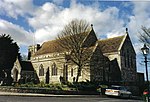Rempstone Stone Circle

Rempstone Stone Circle (grid reference SY994820) is a stone circle located near to Corfe Castle on the Isle of Purbeck in the south-western English county of Dorset. Archaeologists believe that it was likely erected during the Bronze Age. The Rempstone ring is part of a tradition of stone circle construction that spread throughout much of Britain, Ireland, and Brittany during the Late Neolithic and Early Bronze Age, over a period between 3,300 and 900 BC. The purpose of such monuments is unknown, although archaeologists speculate that they were likely religious sites, with the stones perhaps having supernatural associations for those who built the circles. Local folklore holds that the stones arrived in their position after being thrown at Corfe Castle by the Devil. A number of these circles were built in the area around modern Dorset, typically being smaller than those found elsewhere. Most of these Dorset circles are made of sarsen stone, although the Rempstone circle is unique in being made from local sandstone. The southern half of the circle has been destroyed, with five upright and three recumbent stones remaining extant. Having been damaged by eighteenth century clay workings, the monument is at present situated within dense woodland. In 1957, a possible avenue of stones leading to the circle was discovered by ploughing but subsequently removed.
Excerpt from the Wikipedia article Rempstone Stone Circle (License: CC BY-SA 3.0, Authors, Images).Rempstone Stone Circle
New Road,
Geographical coordinates (GPS) Address Nearby Places Show on map
Geographical coordinates (GPS)
| Latitude | Longitude |
|---|---|
| N 50.6385 ° | E -2.0089 ° |
Address
New Road
New Road
BH20 5JQ
England, United Kingdom
Open on Google Maps







